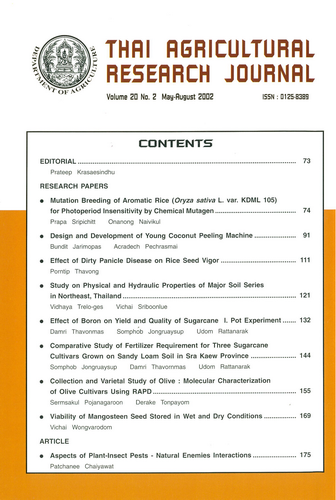Effect of Boron on Yield and Quality of Sugarcane I. Pot Experiment
DOI:
https://doi.org/10.14456/thaidoa-agres.2002.11Keywords:
sugarcane, yield and quality, boronAbstract
The effect of boron supply on the yield and quality of sugarcane var. K84-200 grown in the cement pots was conducted in the glasshouse in 1998-2000. The soil was Korat series (fine loamy, siliceous isohyperthemic, Oxic Paleustults) with pH 5.4, organic matter 0.8% available P 7 mg/kg, exhangeable K 35 mg/kg and boron 0.1 mg/kg. The experimental design was randomized complete block with 4 replications. The treatments consisted of 5 levels of boric acid (0, 2.3, 4.6, 9.2 and 18.4 g/pot with the basal fertilizers N, P2O5 and K2O as 90, 45 and 90 g/pot, respectively.
The results indicated that sugarcane plants responded strongly to boron supply. Consequently, the boron concentration in the third leaf from teh TVD (Top Visible Dewlap) increased as boron increases.
Boron supply had not effect on the growth (height and diameter) and yield of sugarcane. On the contrary, boron supply had the effect on sugarcane quality. With the rate of boric acid 4.6 g/cement pot, sugarcane produced the highest CCS as 12.1% comparing to 9.7% CCS of plants grown without boron supply. Nevertheless, the high level of boron supply upto 9.2 g/pot of boric acid caused the toxic to the plants. The relationship between the boron concentration of the third leaf of plant cane and the % CCS was very poor with R2 = 0.0031 suggesting that this leaf was not suitable for the prognosis of the sugarcane quality.
Downloads
Published
How to Cite
Issue
Section
License

This work is licensed under a Creative Commons Attribution-NonCommercial-NoDerivatives 4.0 International License.
Thai Agricultural Research Journal



